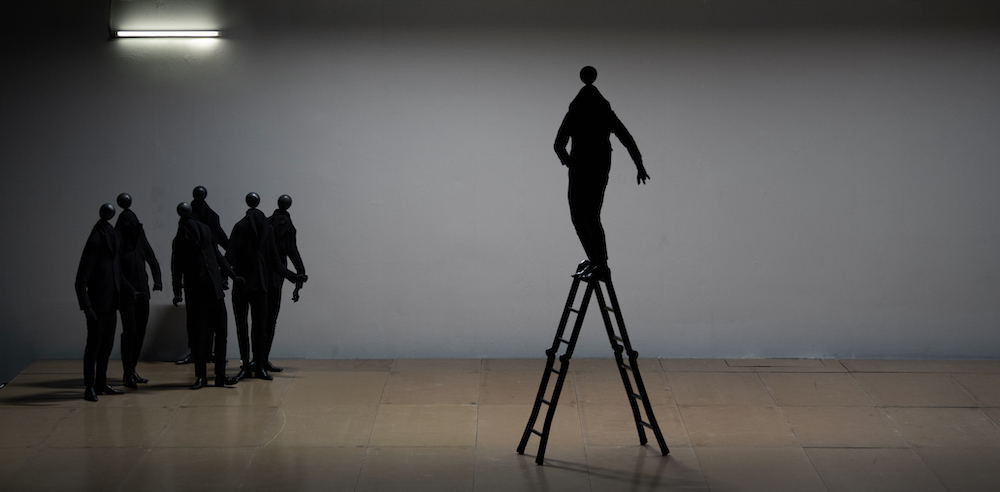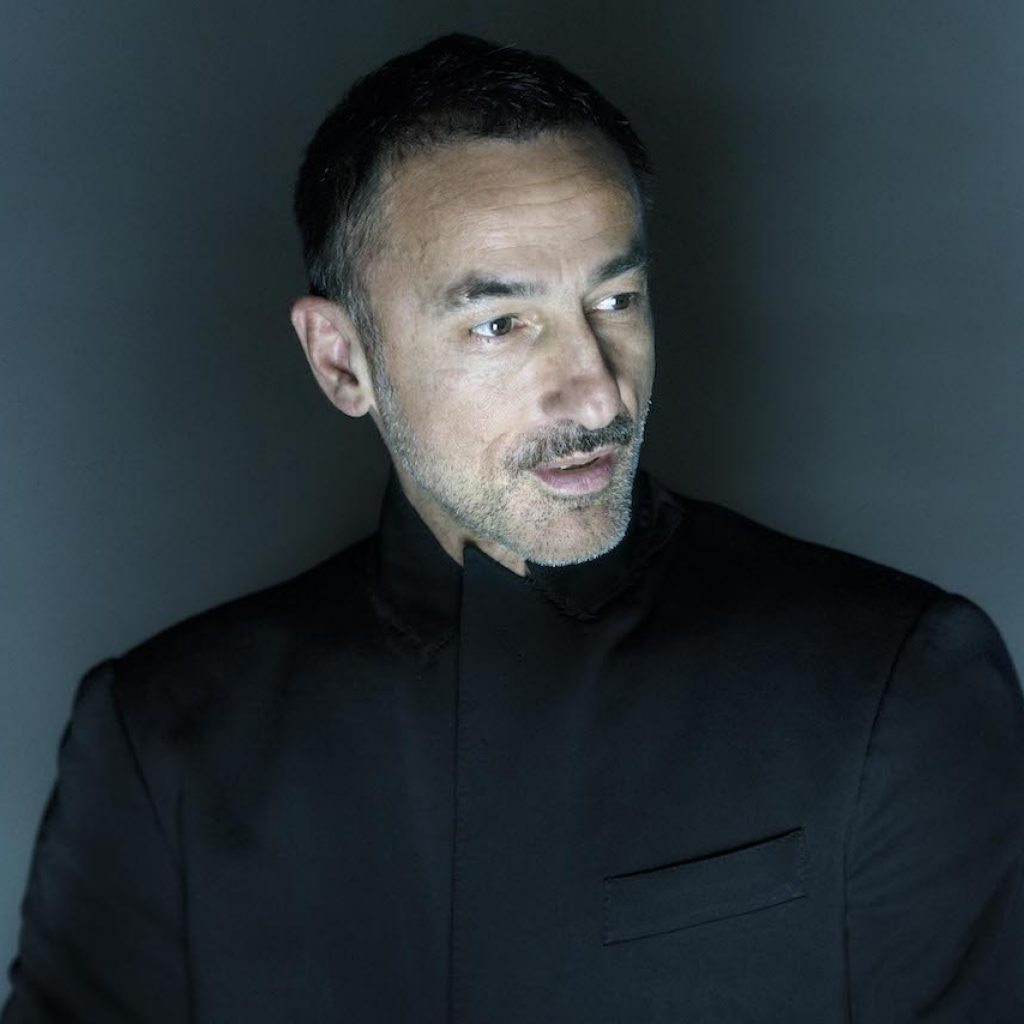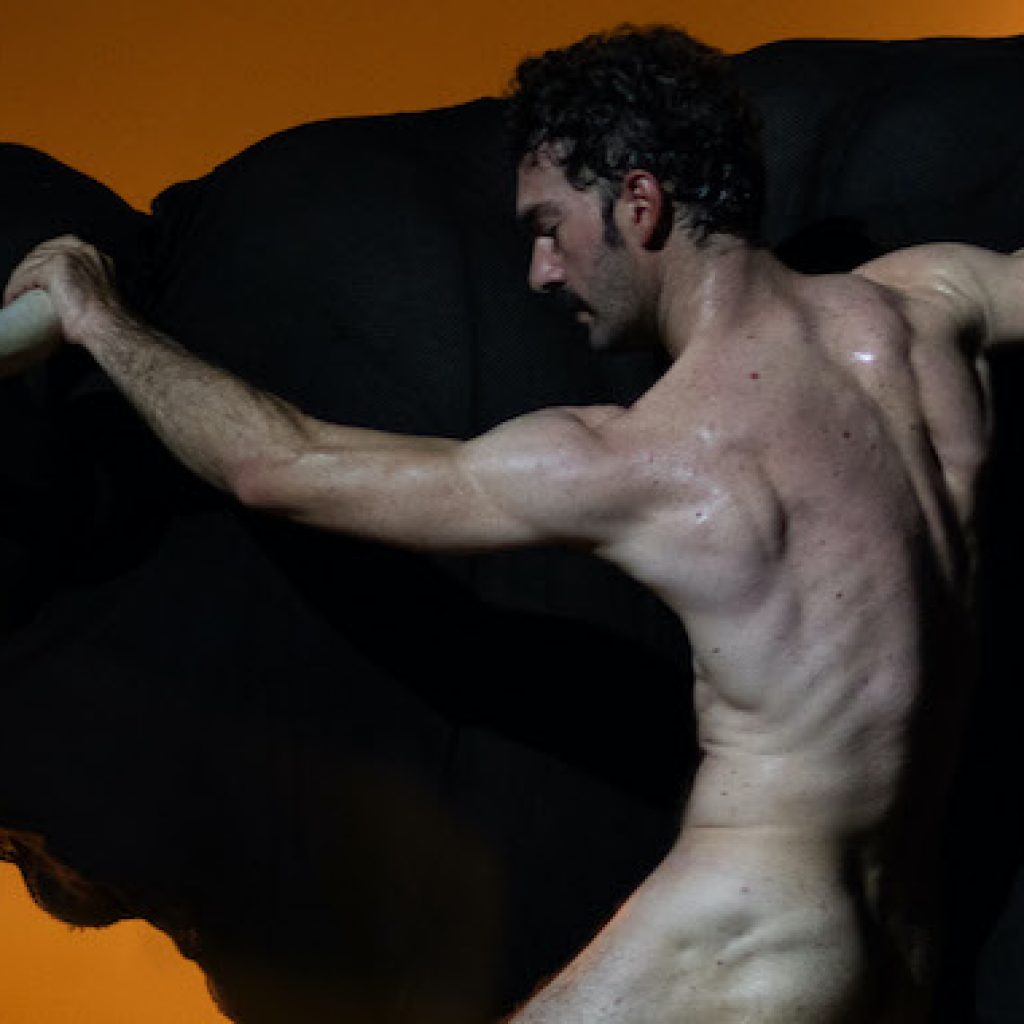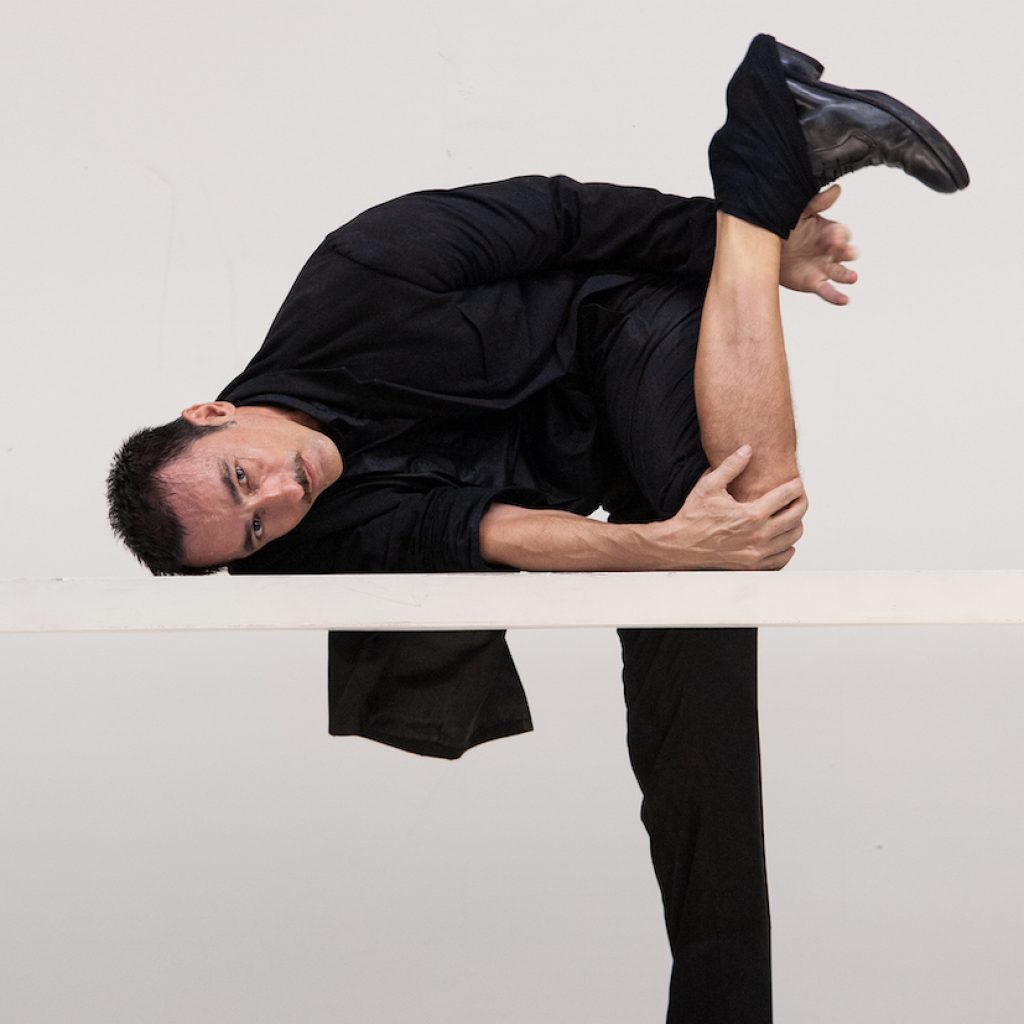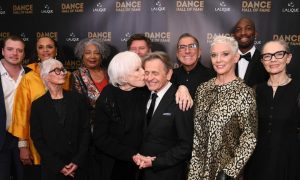Dance Informa has had the wonderful opportunity to speak with world-renowned director Dimitris Papaioannou leading up to his show, Transverse Orientation, which will have its U.S. premiere as part of Brooklyn Academy of Music’s Next Wave Festival this fall. His responses to our questions speak for themselves, and we’re grateful to have caught a glimpse behind the curtain of his distinctive world.
You have a background in visual arts. Can you tell us a little bit about the role that visual art has played and continues to play in your life?
“I am a trained traditional figurative painter. Back in 1982, when I was studying at Athens School of Fine Arts, I had already spent three years as a student of a great Greek painter called Yannis Tsarouchis. He followed my painting exercises and allowed me to watch him as he painted. He was a wise man, somebody who is at the same time extremely modern and traditional. He warned me that it would be very difficult to explain to non-painters what it is to be able to look at things with a painter’s eye. It is this painter’s eye that I use to make my theater. I wasn’t trained in dancing or directing. The only things I can use in terms of selecting the material that will end up on stage are shape, proportions, placement in space, color, and the stories that are told by shadow and light. I am much more traditional as a painter than as a director, and I am currently in a phase where I’m painting frantically. I paint from nature as a form of existential exercise. I paint so that I can see.”
What led your transition from visual art into theater?
“In painting, I was a child prodigy. I was able to earn money from a very young age, which helped me finance myself and run away from home at 18. My parents did not support me becoming an artist, nor did they accept me as a homosexual man. In my first years of studying fine arts, I met a woman who was a dance teacher and choreographer, and she invited me to her classes. Once I got into the studio, I never left. I started dancing obsessively, performing, designing clothes and sets and lights for her. I was drawn into the theater world, and gradually it absorbed me without my noticing. I never sat down to make a decision or think about becoming a theater artist, nor did I think about financial survival. I was drunk with it, and after the first few years of supporting my theater making with painting, it started supporting itself.”
How does Greek antiquity inform your work? Do you take inspiration from the city of Athens and its incredible history?
“I do take a lot of inspiration from the city of Athens. It is my hometown, where my first emotions stirred up my soul. I used to design comics, and all the stories I created were of a solitary boy in the jungle of a big city that I thought Athens was back then. I don’t seek out antiquity or myths or archetypes; they just come to me as I am workshopping ideas, and I embrace them because they offer a visual landscape of ideas and symbols that audiences in the whole world (and especially in the Western world) can connect to. Since I’m not using language and I’m not choreographing steps (because I don’t know how), I use these evolving images to communicate. Whenever a body reminds me of an archetype from antiquity and it’s useful for my storytelling, I embrace and encourage it. I know that many see my work as composed of art history references and comments on ancient myths, but this is not my intention. I understand why people interpret the work this way given that I am a Greek artist and I use a lot of nudity in my work, but these things come to me rather than me going toward them.”
Do you consider your work overtly spiritual?
“It is very dangerous territory to talk about myself. I often question whether there is something more than matter, and this always comes up in my work. In dance, traditionally, but in my kind of dance theater as well, there is a battle with gravity. There is this tendency to overcome gravity, and this force that is pulling you down at the same time gives you all the mechanics and creates all the structure in your bones, musculature, neurons, etc. to rise up. The duality of down and up can be taken as a commentary on the duality of material and spiritual existence. In The Great Tamer, for example, there is the gravity of the fabric violently covering the recumbent body, and the lightness as it is uncovered by a gust of wind; the brutal gravity of matter brings death with it, but there is also the hope for a soul that lifts existence out of a dead body. I don’t have any answers, but I have noticed that I play around with such ideas a lot.”
Your work is often listed as both dance and theater, and when I saw The Great Tamer, I understood why. Do you think there’s a certain genre your work best fits, or do you find such distinctions arbitrary?
“Out of respect for the pure genre of dance and choreographers like Forsythe, De Keersmaeker, Balanchine and Cunningham, I cannot place myself in the same genre. These artists know how to create structures in space and time with codified human movement, and they tell all sorts of abstract stories with that. I am completely incapable of creating anything of the sort –– I simply do not speak the language –– and they have my total respect. Through the evolution of contemporary theater, in recent times it is contemporary dance that has created space for hybrid works, and I stepped in there. I don’t know if I’m closer to theater because I don’t use speech. Theater is text, and we have a great tradition of theater in Greece; I have worked with some of the best directors we have, and I have seen how speech is directed, and I know nothing about that either. My urge is to create live action on stage, and it seems that over the years there is something interesting I have done that cannot be exactly characterized as one or the other or even as in between like the Tanztheater Wuppertal of Pina Bausch. I don’t know exactly where to place myself and feel enormously grateful that there is space for my thing as well in festivals and in audiences’ imaginations.”
What is the background of most of your performers and how collaborative is your process with them when creating a new show?
“In Transverse Orientation, they are all dancers. In The Great Tamer, there were also two actors and one b-boy. In previous pieces, I have worked with a mix of actors and dancers, but the actors must have great physical ability or sensitivity and developed kinaesthesia. The first time I held an international audition was for Transverse Orientation, so the cast is not all Greek. This interesting new procedure has offered me a variety of new experiences with different cultures and talents. My process is very collaborative, but I take full responsibility for the end result and really want to control it; I take the risk of making all the artistic decisions regarding the composition of the piece, but during the process I have no idea what I’m doing. I just have a bunch of ideas: how would it be if we move an enormous bull puppet like we’re trying to control it? We are a bunch of people playing ridiculously with every possibility. What sound does this make? How does the material bend? How can we combine our bodies? How can we make a Sphinx? We embark on a completely surrealistic procedure of inventions, and I select things that for some reason seem interesting. This half of the procedure is extremely collaborative and dependent on the connection amongst the performers and their connection with me, on their creativity and inventiveness. It is the most joyous and carefree phase. The second half is composition where I struggle with creating a mosaic from the fragments I have. Usually the fragments are visual ideas, relationship ideas, and movement ideas ranging from a few seconds to one to two minutes long. It’s like putting together a puzzle without knowing what the final image will look like. Chasing in the dark with notebook sketches as my guide. I make hundreds of sketches because when I’m rehearsing, I want to be able to glance at a figure that reminds me of a scene with the edge of my eye. I don’t have time to read and my notation system is more like hieroglyphics.”
Do you still perform, or are those days in the past?
“I constantly performed in my works until I was 37. I was then assigned to create the Opening Ceremony of the Olympic Games in Athens, so I stopped creating my own work and dedicated myself to that enormous task for the next three years. After the Olympics and a recovery year off, I looked back at videos of what I’d been doing for 20 years and I disliked my work. I realized I had to get more serious and I became very strict with myself, stepping out of performing and concentrating on directing. When the financial crisis hit in 2012, I decided that as one of the people who had been blessed with the maximum means to create theater, my only political statement would be to create the most poetry with the minimum amount of means. I went into my storage unit, took two to three props, and joined with a friend to create Primal Matter, which was the rebirth of my creativity out of nothing. Me, another body, a panel, a chair, no music, no lights, nothing. I stepped into my work again, and it redefined me; I not only stripped my creation down to the essentials, but I also gave my own stamina, sweat and commitment as a performer which reconnected me to my work in an organic way. Primal Matter was the beginning of my latest period of creation, and it’s the work that all the following works are hidden inside. It is still personally my favorite creation.
Transverse Orientation was interrupted by COVID, and after six months of halting and pausing, I stepped into the studio again with a new friend and created Ink. It hasn’t toured internationally yet, but it will after Transverse Orientation. So, at 58, I am back on stage performing in my work. Every now and then, I try to do something on stage to reconnect myself with my work and attempt to open new territories. When I perform, I am more daring, more experimental and more ridiculous.”
Despite the serious tone present in much of your work, it is also bursting with humor. How does this humor manifest in the creative process?
“Our procedure is full of laughter. I encourage ridiculousness and because nudity is coming, we end up in relationships that are more unhinged, which liberates us to be very friendly with each other; we don’t have a feeling of professional distance. We do not laugh with the jokes that I create on stage. We laugh with the procedure itself. What’s interesting is that the sense of humor and ridiculousness, even the slapstick energy that I place on the piece, is not perceived by the performers while we are arranging it. Usually, my performers understand the humor after the first few contacts with the audience. All the atmosphere that seemed melancholic and meditative is interwoven with sarcasm, irony and ridiculous humor, and every time they realize that, they get so excited that they are going to perform a kind of meditative comedy on stage. When humor is revealed to the performers together with the audience, it’s my secret in the procedure. Some audiences believe that something I find just meditative or tragic is humorous as well. I know where all the jokes are, but some audiences reveal a funny side of other scenes that I had not thought of as funny.”
What has the trajectory of your work looked like, and do your works have clear relations to each other in your mind? Do they build upon one another?
“In retrospect, I see the connecting dots and understand why there is something called a style or atmosphere that characterizes my work. I always hope to break free from all those things when I make something. I always want to find a door and get out of myself and find something extremely interesting, unpredictable and completely unlike me, but I always end up creating work that seems to be one more step in a kind of unified universe. I don’t have a plan. I don’t have a wish except the wish to escape myself, but I don’t seem to be able to do that. I just hope I am maturing and that my work matures as I do –– that I am a little less shallow, less random and less predictable each time.”
What about scale? Do you have a preference for smaller or bigger casts?
“I am very grateful to have had two chances to create the largest shows that can be created on Earth — the opening ceremonies of the Summer Olympics and the European Games. I know now how it is to do that kind of work, and I was able to experiment with some solutions regarding how it might be possible to create at such a grand scale while retaining intimacy and fostering emotions other than those of grandeur — the emotions of being moved by existing as a human on Earth. I prefer working at a medium scale because I can do it in my own studio with my friend, a producer who I’ve been working with for 25 years. Sometimes, I like to come back to a small scale where I can manage almost everything with my own hands.”
Have interactive sets always been part of your work, and how has your use of sets and objects evolved over time?
“There isn’t a single piece I’ve made where the objects and sets aren’t being used organically, and they are always crucial for the development of a piece’s story and energy. I don’t work with backgrounds or decorative sets. Halfway through the process, I have to decide how the space will be and create a sketch of it: uneven surfaces, walls, water, holes the performers can fall into, etc. I consider space and objects elementary for my creative procedure, and the way that the bodies are challenged by the spatial parameters and interact with objects is crucial for my creation. I sketch costumes and objects and sets and lighting very early on. I have a lot of junk so we just throw it in the space. The panels that are the protagonists of The Great Tamer, for example, came from my storage unit. I brought them in one day and we started playing with them; we created a sound, broke one, threw one, and before we knew it, the panels became an important part of the story. In the duet, Ink, I used the floor of Medea, a piece I had created when I was 30 years old, in order to flood the floor. Then, I went out to the garden and brought in a sprinkler, and it became the protagonist of the show. I don’t dream of something and wait to get it. Very rarely do I do that (as in the case of the bull of Transverse Orientation).”
What is or has been your biggest challenge as an artist?
“I’m not sure how to answer that question. My continuous challenge is to take a step toward honesty every time I’m working, and not to become a franchise of myself. I’m always present with my work; audiences know I’m always there, having rehearsed and delivered the show. I travel with my group, so I cannot do parallel projects, and that makes it difficult to survive in the art market, but I am trying to respond to this challenge of being honest and personal with my art the best way I can. I strive not to be carried away by anything unnecessary that is connected to my career rather than my work.”
Who are your greatest artistic inspirations? Is dance a significant part of your artistic diet?
“My main inspiration is life of course. But artistic inspiration comes primarily from movies, music and visual arts. Yannis Kounellis, Yannis Tsarouchis and David Hockney are three giants of visual arts that I’m always inspired by. Federico Fellini and Pier Paolo Pasolini are my most intimate cinema inspirations. Dance is not the protagonist, but my first shock in live theater was Cafe Mueller by Pina Bausch. When I first saw Robert Wilson’s work and was allowed to watch his procedures, an explosion in my head unlocked the potential that exists on stage. And lately, I have been inspired by Romeo Castellucci and the way he arranges space. Every time I see Forsythe’s work, I bow. He is the Michaelangelo of dance.”
Transverse Orientation will be presented at BAM’s Next Wave 2022 from November 7-11. For tickets and more information, visit www.bam.org/transverse-orientation.
By Charly Santagado of Dance Informa.


